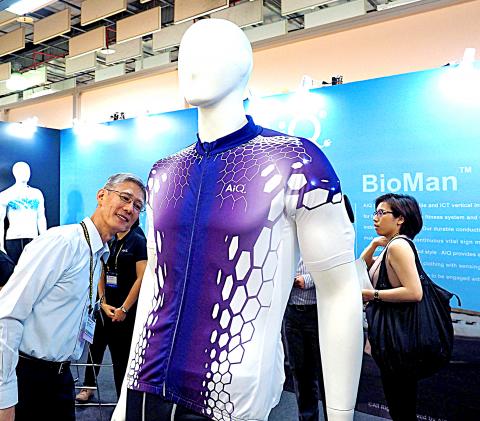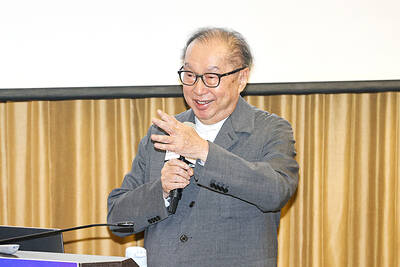A new generation of wearable technology is promising not only to log data about users’ health, but to predict and avert crises — from drivers falling asleep at the wheel to runners wearing themselves out in a marathon.
However, there are concerns over the accuracy of the personal information collected by the burgeoning range of smart wristbands, watches and clothing — and how companies might use that data.
Wearable technology is the fastest-growing category at this year’s Computex, which started in Taipei on Tuesday, with health-tracking a dominant theme.

Photo: EPA
“Health and fitness sensors and data are fundamental for wearables, and largely define the category,” Daniel Matte of market research firm Canalys said.
At Taiwanese smartwear company AiQ Smart Clothing Inc’s (愛剋智慧科技) stand this week, a muscular mannequin showed off a Lycra cycling top. Stainless steel fibers in the fabric and electrodes in the sleeves sense heart rate and other vital signs, as well as calories burned, sending the data to a Bluetooth clip, which can transmit it to a smartphone, tablet or other smart device.
The technology will appeal to sports fans, but it is Taiwan’s bus drivers who will be the first to benefit, when companies ask them to wear smart shirts later this year in a move that could prevent accidents.
“We will provide a shirt which can monitor the drivers in case they are falling asleep, or in case any vital signs are not OK, and it will provide a signal or a warning to the bus company,” AiQ vice president Steve Huang (黃宏旭) said.
The clothing was trialed for a year on discharged hospital patients to track their condition and it received positive feedback from wearers, he added.
Acer Inc (宏碁) also revealed its first wearable at Computex — a fitness-tracking wristband which links to a smartphone.
However, analysts and consumers still have reservations about whether smartwear can really tell us the truth about our bodies. There are also questions over how the huge flow of data from the new devices will be handled.
“Current sensors are not very accurate, but there will be improvements,” Matte said.
“There is a massive opportunity to analyze and monetize the large amounts of data that wearable sensors and platforms will generate. Privacy is always a concern,” he said.
Huang acknowledged the tension between the potential commercial benefit for smartwear firms and the risk of invading users’ privacy.
“There will be a lot of legal and moral issues,” he said.
Tech companies are also emphasizing the potential benefits of analysis to help users make sense of their data, and the possibility of linking up with experts who can give them feedback.
“Maybe we will cooperate with some medical [institutions] like hospitals to improve this kind of product and to do something to really help people — this has been talked about at Sonostar,” Paula Luh said at Sonostar Inc’s (南北星) stand.
The Taiwanese firm was showing its new brightly colored SmartFit trackers — silicone wristbands with a pop-out, coin-sized sensor which is battery-powered and designed to be worn all day, monitoring everything from steps taken to sleep patterns.
The device has one year’s memory storage, said Luh, who added that users’ privacy would be protected through a registering and sign-in procedure to access their personal data online.
Smart wearables could also be set to re-educate athletes away from a “no pain no gain” approach, with one new device at Computex claiming to be able to measure “stamina” so that it can warn racers when they might be pushing too hard.
“We detect the current flowing through your heart... then we use our algorithm and transfer the raw information into stamina,” said Kuo Hsin-fu (郭信甫) of Taiwanese startup Bomdic Inc (博晶醫電), which makes the clip-on Bluetooth “GoMore” device.
By analyzing the user’s heart activity the device can predict lactic acid build-up and other physical factors which can affect performance, Kuo said, with stamina shown as a percentage level.
“Most of the [smart] bands focus on general users, but our target audience is athletes. The ones who have tried it love it — it’s good for training and competition efficiency,” he said.
“We are doing everything that other sports apps can do, but more,” Kuo added.

BYPASSING CHINA TARIFFS: In the first five months of this year, Foxconn sent US$4.4bn of iPhones to the US from India, compared with US$3.7bn in the whole of last year Nearly all the iPhones exported by Foxconn Technology Group (富士康科技集團) from India went to the US between March and last month, customs data showed, far above last year’s average of 50 percent and a clear sign of Apple Inc’s efforts to bypass high US tariffs imposed on China. The numbers, being reported by Reuters for the first time, show that Apple has realigned its India exports to almost exclusively serve the US market, when previously the devices were more widely distributed to nations including the Netherlands and the Czech Republic. During March to last month, Foxconn, known as Hon Hai Precision Industry

Taiwan Semiconductor Manufacturing Co (TSMC, 台積電) and the University of Tokyo (UTokyo) yesterday announced the launch of the TSMC-UTokyo Lab to promote advanced semiconductor research, education and talent development. The lab is TSMC’s first laboratory collaboration with a university outside Taiwan, the company said in a statement. The lab would leverage “the extensive knowledge, experience, and creativity” of both institutions, the company said. It is located in the Asano Section of UTokyo’s Hongo, Tokyo, campus and would be managed by UTokyo faculty, guided by directors from UTokyo and TSMC, the company said. TSMC began working with UTokyo in 2019, resulting in 21 research projects,

Ashton Hall’s morning routine involves dunking his head in iced Saratoga Spring Water. For the company that sells the bottled water — Hall’s brand of choice for drinking, brushing his teeth and submerging himself — that is fantastic news. “We’re so thankful to this incredible fitness influencer called Ashton Hall,” Saratoga owner Primo Brands Corp’s CEO Robbert Rietbroek said on an earnings call after Hall’s morning routine video went viral. “He really helped put our brand on the map.” Primo Brands, which was not affiliated with Hall when he made his video, is among the increasing number of companies benefiting from influencer

Quanta Computer Inc (廣達) chairman Barry Lam (林百里) yesterday expressed a downbeat view about the prospects of humanoid robots, given high manufacturing costs and a lack of target customers. Despite rising demand and high expectations for humanoid robots, high research-and-development costs and uncertain profitability remain major concerns, Lam told reporters following the company’s annual shareholders’ meeting in Taoyuan. “Since it seems a bit unworthy to use such high-cost robots to do household chores, I believe robots designed for specific purposes would be more valuable and present a better business opportunity,” Lam said Instead of investing in humanoid robots, Quanta has opted to invest